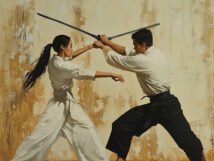Introduction: The Art of Martial Arts and Its Physical Impact
Martial arts have been practiced for centuries and have gained immense popularity worldwide. From traditional forms like karate and kung fu to modern disciplines like mixed martial arts (MMA), martial arts offer a unique combination of physical fitness, self-defense skills, and mental discipline. While the mental and spiritual aspects of martial arts are often emphasized, it is important not to overlook the physical impact that these practices have on the body.
The Physics of a Punch: Understanding Force and Momentum
To understand the physical impact of martial arts, it is essential to delve into the physics behind a punch. Force and momentum are two key concepts that come into play when throwing a punch. Force is defined as the push or pull on an object, while momentum is the product of an object's mass and velocity. When a punch is thrown, force is generated by the muscles in the body, and momentum is transferred from the body to the fist.
The relationship between force, momentum, and punching power is crucial. The more force that is generated and transferred to the fist, the greater the momentum and the more powerful the punch. This is why proper technique and body mechanics are essential in martial arts. By maximizing the force generated and the transfer of momentum, martial artists can deliver powerful and effective punches.
The Anatomy of a Punch: Which Muscles Are Involved?
A punch involves the coordinated effort of several muscles in the body. The primary muscles involved in a punch are the muscles of the upper body, including the chest, shoulders, and arms. The pectoralis major and deltoid muscles in the chest and shoulders are responsible for generating the force needed to throw a punch, while the biceps and triceps in the arms provide the power and control.
In addition to the upper body muscles, the muscles of the core and lower body also play a crucial role in generating power in a punch. The muscles of the core, including the abdominals and obliques, provide stability and transfer force from the lower body to the upper body. The muscles of the lower body, such as the glutes and quadriceps, generate power and provide a solid base for the punch.
Muscle strength and flexibility are essential in martial arts. Strong muscles are able to generate more force, while flexible muscles allow for a greater range of motion and better technique. Regular strength training and stretching exercises are therefore important components of martial arts training.
The Role of Body Mechanics in Martial Arts
Body mechanics refers to the efficient use of the body's muscles and joints to generate power and perform movements. In martial arts, proper body mechanics are crucial for maximizing punching power and accuracy. This involves using the body's natural alignment and structure to generate force and transfer it to the target.
Proper body mechanics in a punch involve aligning the body's joints, such as the hips, shoulders, and wrists, to generate maximum force. This allows for a more efficient transfer of force from the lower body to the upper body and ultimately to the fist. Additionally, proper body mechanics help maintain balance and stability during a punch, reducing the risk of injury.
The Importance of Footwork in Generating Power
Footwork is an often overlooked aspect of martial arts, but it plays a crucial role in generating power in a punch. Proper footwork allows martial artists to generate force from the ground up, transferring it through the legs and into the upper body. This is known as the kinetic chain, where force is transferred through a series of joints and muscles.
In addition to generating power, footwork also affects balance and stability. By maintaining a solid base and proper weight distribution, martial artists can deliver powerful and accurate punches. Footwork also allows for quick and agile movements, enabling martial artists to evade attacks and create openings for counterattacks.
The Science of Breathing and Its Effect on Punching Power
Breathing is a fundamental aspect of martial arts and has a direct impact on punching power. Proper breathing techniques help martial artists generate more force and maintain stability during a punch. When a punch is thrown, exhaling forcefully through the mouth helps engage the core muscles and generate more power.
In addition to generating power, proper breathing techniques also help martial artists maintain focus and control. By controlling their breath, martial artists can regulate their heart rate and stay calm and composed during intense situations. This is particularly important in combat sports like MMA, where split-second decisions can make all the difference.
The Impact of Training on Punching Speed and Accuracy
Training is a crucial component of martial arts and has a significant impact on punching speed and accuracy. Through consistent and focused training, martial artists can improve their technique, strength, and speed, resulting in more powerful and accurate punches.
Training techniques for punching speed and accuracy include shadowboxing, bag work, and pad work. Shadowboxing allows martial artists to practice their technique and footwork without a partner, while bag work and pad work provide resistance and feedback. By incorporating these training techniques into their routine, martial artists can improve their punching speed and accuracy over time.
The Relationship Between Martial Arts and Bone Density
Bone density refers to the amount of mineral content in the bones, which determines their strength and resistance to fractures. Martial arts, particularly those that involve striking and impact, can have a positive impact on bone density. The repetitive stress and impact on the bones during training stimulate bone remodeling, leading to increased bone density.
Regular martial arts training, combined with a balanced diet rich in calcium and vitamin D, can help improve bone density and reduce the risk of osteoporosis and fractures. However, it is important to note that excessive or improper training can also increase the risk of injury, including stress fractures. Therefore, it is crucial to train under the guidance of a qualified instructor and listen to your body's limits.
The Risks of Repetitive Trauma and How to Prevent Injury
While martial arts offer numerous physical benefits, there are also risks associated with repetitive trauma. The repetitive impact on the body, particularly the joints and soft tissues, can lead to overuse injuries such as tendonitis and joint pain. It is important to listen to your body and take appropriate rest and recovery periods to prevent these injuries.
Proper technique is also crucial in preventing injury. By using proper body mechanics, martial artists can minimize the stress on their joints and soft tissues. Additionally, wearing protective gear, such as hand wraps and mouthguards, can help reduce the risk of injury during training and sparring.
Conclusion: The Benefits and Limitations of Understanding the Science Behind the Punch
Understanding the science behind the punch can provide valuable insights into the physical impact of martial arts on the body. By understanding the physics, anatomy, and mechanics involved in a punch, martial artists can optimize their training and improve their performance.
However, it is important to note that relying solely on science can have limitations. Martial arts are not just about physical fitness and technique; they also encompass mental discipline, self-defense skills, and personal growth. Therefore, while understanding the science behind the punch is beneficial, it should be balanced with the holistic approach of martial arts.
In conclusion, martial arts have a profound physical impact on the body. From the physics of a punch to the anatomy of the muscles involved, every aspect of martial arts training contributes to the development of strength, power, and accuracy. By understanding and incorporating the science behind the punch into their training, martial artists can enhance their performance and reap the numerous benefits of this ancient art form.













